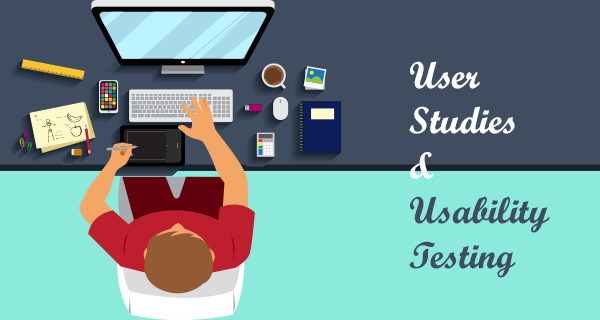5 User Study Methods and When to Use Them
We all know that rich user data is a holy grail for a successful product design, but how to find and use this holy grail is what very few UX designers struggle with.
User studies methods and usability testing are an important source of user data and actually a very exciting part of UX research. It is where you really get to work with actual people, watch them use your product and observe how your own stereotypes about UX and usability crash leaving space for newfound knowledge about your very own users.

So let’s jump right in and start with the main methods for studying the users.
There are two main questions that we need to answer:
- How you can study user behavior?
- When and which user study method you should use?
It is largely acknowledged that user studies are most efficient when performed on the early stages of product development, so that this data can be used to create personas and scenarios as well. However, it is never too late to start, because you can still align your strategy according to the new user data.
When doing a user study it is very important to choose the right method in order not to waste your time and money for information you already know or simply do not need. So let’s look at the most common user study methods that you can choose from:
- Contextual interviews
- One-on-one interviews
- Focus groups
- Surveys
- Usability Testing

Contextual interviews are basically personal meetings with users in their own natural environment when and where they use the product. As a researcher you get the chance to observe the whole context in which your product is used. You see all the tiny details, like for example:
- is she multitasking while using your service, switching back and forth between the browser tabs
- does she use a mouse for scrolling or the arrow keys on the keyboard
- what is the internet connection like, etc.
Contextual interviews tend to be more like observations rather than real Q&As. You can certainly ask questions along the way, but there are usually no predefined scenarios or tasks to complete and all you have to do is take notes or record what the user thinks and does.
During contextual interviews you will gather lots of qualitative data which can be especially useful when combined with other UX research methods, like usability testing or online surveys. They can also be used when you need to understand specific problems that users encounter when using the product.
For instance, if you have a mobile app analytics service and users have trouble setting up the tracking of custom events, you might decide to see them using the service on their own computers with their own internet connection to better understand the core of this issue.
While it might seem that contextual interviews are the same as one-on-one interviews because you get to talk to individual users, but the actual research activities for these two methods are completely different. During a one-on-one interview, the researcher usually has a semi-formal conversation with the user without having her perform product-related tasks. So it is more like a real interview which helps you dive deeper into the attitudes, beliefs, desires, and experiences of the user so that you can better understand how to satisfy their needs.
Individual interviews are ideally conducted face-to-face, however sometimes it might be hard meeting users in person, so you might interview them by phone, video call or instant messaging.
These interviews just like most of UX research is recommended to conduct on early stages of product development, but then again you may feel like doing some interviews with your users before launching a redesign or a new feature. This way you will have a comprehensive feedback early on and improve accordingly.

Moving on to focus groups, these are basically the same conversational interviews conducted in groups, with several people at once. Focus groups are initially a marketing technique, which you can use for UX research purposes as well. In a typical focus group, users talk and discuss their preferences, expectations and opinions regarding different topics that are given by the researcher.
The main advantage of focus groups is that they are a quick and cost-effective way of obtaining broad range of information about user perceptions and feelings towards your product or service. So this method can be used to gather valuable feedback and suggestions on improving your product and services.
Surveys are also a common research method employed in a number of fields, from marketing to psychology. A survey is usually a questionnaire designed to gather both quantitative and qualitative information in a quick and easy way. You can run a survey whenever you feel the need to supplement the qualitative research with some numerical data or simply to gather structured and easy-to-analyze information from your user base.
Last but not least, usability testing is a UX-specific research method that sort of combines all of the user research methods listed above. It is traditionally a lab study, where you get to work with a few, usually up to 10, users one-by-one. But don’t stress out if you do not have a specially designed lab, because there are a number of online tools that can help you run the test remotely just as successfully as you would in a physical lab.
During the usability test users perform predefined tasks while researchers observe, take notes and occasionally ask extra questions to clarify certain points. Usability testing reveals quite a lot of problems that both designers and developers can easily miss out simply because they are already too used to the product. During the test you will be able to gather both quantitative and qualitative data, such as:
- time on task,
- task completion/success rate,
- task error rate,
- overall satisfaction level,
- useful suggestions on improvements.
It usually takes 3-4 users to identify some of the biggest faults in your UX design and development, so you don’t need to run a large-scale study with hundreds of participants. It is actually far more effective to run more tests with fewer participants than vice-a-versa. I would recommend fixing the major usability issues that were discovered during the first test and then conducting a repeat test to validate the updated version of the product design.
The biggest and probably the only drawback of usability testing is that it is quite costly, especially if you go the traditional way and rent a lab, testing equipment and decide to compensate the participants. You can reduce this cost by switching to online remote testing, but if you want a professional tool and trustworthy results, it will still require a solid budget.
Conclusion
There are dozens of user research methods and each of them has its advantages and disadvantages, so the choice really depends on the type of data you need to gather and the final goal of your research. Setting clear objectives and recruiting the right participants is key to running a successful user study, so make sure to deeply understand what issues you are trying to solve and who is the target audience of your product or service.